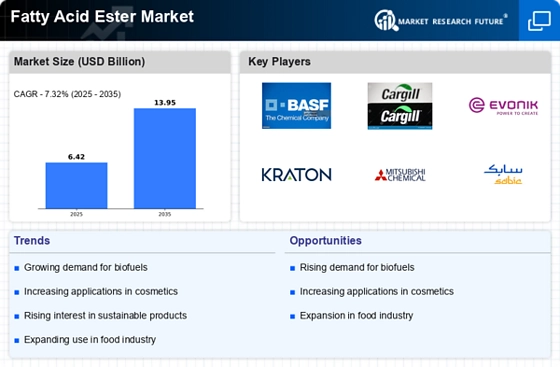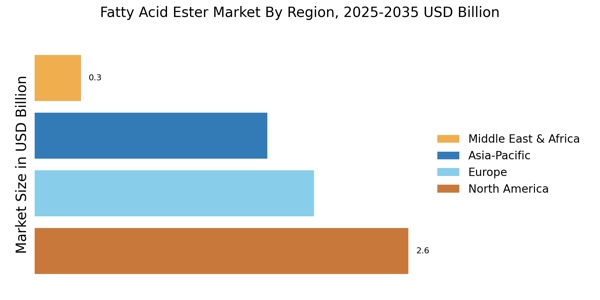Rising Demand for Biofuels
The increasing emphasis on renewable energy sources is driving the demand for biofuels, which prominently utilize fatty acid esters. As countries strive to meet environmental regulations and reduce carbon emissions, the Fatty Acid Ester Market is witnessing a surge in production. In 2025, the biofuel sector is projected to grow at a compound annual growth rate of approximately 8%, indicating a robust market for fatty acid esters derived from vegetable oils and animal fats. This trend is further supported by government incentives aimed at promoting sustainable energy solutions, thereby enhancing the market landscape for fatty acid esters.
Growth in Personal Care and Cosmetics
The personal care and cosmetics sector is increasingly incorporating fatty acid esters due to their emollient properties and skin compatibility. The Fatty Acid Ester Market is benefiting from this trend, as these compounds are utilized in formulations for moisturizers, creams, and lotions. In 2025, the personal care market is expected to reach a valuation of over 500 billion, with fatty acid esters playing a crucial role in enhancing product performance. This growth is indicative of a broader consumer shift towards products that are both effective and derived from natural sources, thereby bolstering the demand for fatty acid esters.
Innovations in Industrial Applications
Innovations in industrial applications are contributing to the expansion of the Fatty Acid Ester Market. These esters are increasingly utilized in lubricants, coatings, and plastics, where they serve as performance enhancers. The industrial lubricants market is projected to grow at a rate of 5% annually, with fatty acid esters being favored for their biodegradable properties and efficiency. This trend reflects a broader movement towards sustainable industrial practices, which is likely to further stimulate the demand for fatty acid esters across various sectors.
Expansion in Food Industry Applications
The food industry is increasingly adopting fatty acid esters as emulsifiers and stabilizers, which is propelling the Fatty Acid Ester Market forward. These compounds are essential in improving the texture and shelf life of various food products. In 2025, the food emulsifier market is anticipated to grow significantly, with fatty acid esters accounting for a substantial share. This growth is driven by consumer preferences for clean-label products and the need for functional ingredients that enhance food quality. As such, the demand for fatty acid esters in food applications is likely to continue its upward trajectory.
Regulatory Support for Sustainable Practices
Regulatory frameworks promoting sustainable practices are significantly influencing the Fatty Acid Ester Market. Governments worldwide are implementing policies that encourage the use of biodegradable and environmentally friendly products, including fatty acid esters. In 2025, the regulatory landscape is expected to become increasingly favorable, with more stringent guidelines on synthetic chemicals. This shift is likely to enhance the market for fatty acid esters, as manufacturers seek to comply with these regulations while meeting consumer demand for sustainable alternatives. The alignment of regulatory support with market trends suggests a promising future for fatty acid esters.


















Leave a Comment